R&D Record Finder for Jira
Visit onlineCase Study: Designing the Jira Connection Module
Issues in Jira are matched to projects and activities within the R&D Tax Incentive Platform using OpenAI API
I. Introduction
Project Goal
To design a seamless user interface integrating Atlassian Jira with Synnch, enabling users to efficiently pull Jira tickets, compare them against R&D activities within Synnch, and automatically generate relevant R&D activity summaries leveraging OpenAI's API.
Product Context
Synnch is a SaaS platform for Australian R&D Tax Incentive claims.
Recognizing that many tech companies track development work (including potential R&D) in Jira, this module bridges the critical gap between project execution (Jira) and R&D claim documentation (Synnch).
Users include Project Managers, Developers, and R&D Consultants familiar with one or both systems.
The Problem
Manually duplicating R&D activity details from Jira into Synnch (or other documentation) is highly inefficient, time-consuming, and prone to inconsistencies.
Role & Responsibilities
UI/UX Designer
- Translated integration requirements into a usable workflow
- Collaborated closely with the Product Owner and Developers
- Designed the multi-step connection setup: selecting Jira issues and selecting Synnch projects and activities
- Designed the core comparison/matching UI
- Designed the generated summary view with editing capabilities
II. Design Process
Methods
As the new financial year approached, our team started prepping for the R&D Tax Incentive submission. This actually sparked an idea from our own internal workshop: how could we spend less time on R&D documentation ourselves? The executive team took that initial thought, looked into what other Jira integration apps were doing, and mapped out the whole process – what goes in, what comes out, and what the system needs to do. I also sketched out who'd be using this, considering both our tech-savvy users (those comfortable with JQL and APIs) and folks who use Jira more casually and need things clearly laid out.
💡 Key Insights
- Internal Need Validation: The feature directly addressed a validated internal pain point, suggesting strong potential value for similar tech companies.
- Simplicity & Guidance Crucial: Despite potentially tech-savvy users, the multi-step data matching process was inherently complex and data-heavy. Each step required clear explanation and intuitive design.
- User Control is Key: Users needed granular control over which Jira projects and issue types to sync.
- Clarity in Matching: The interface for comparing potentially hundreds of Jira tickets against Synnch activities needed exceptional clarity.
- Flexibility Needed: Generated summaries required easy editing capabilities before finalization.
- Secure & Standard Connection: OAuth for Jira authentication was identified as the standard, secure approach.
III. Ideation & Design Exploration
Process Mapping & Flow Definition

R&D Record Finder for Jira Process Map
Step by Step Design
Consciously broke down the complex workflow into logical, manageable screens/steps to avoid overwhelming the user.

IV. Design Execution
Guided Setup Wizard
Designed a multi-step flow clearly guiding users through checking Synnch pre-requisites, authenticating with Jira via OAuth, and selecting Jira tickets using flexible methods (JQL, Project Selection, Saved Filters), providing counts of pulled issue types (Epics, Stories, Tasks).
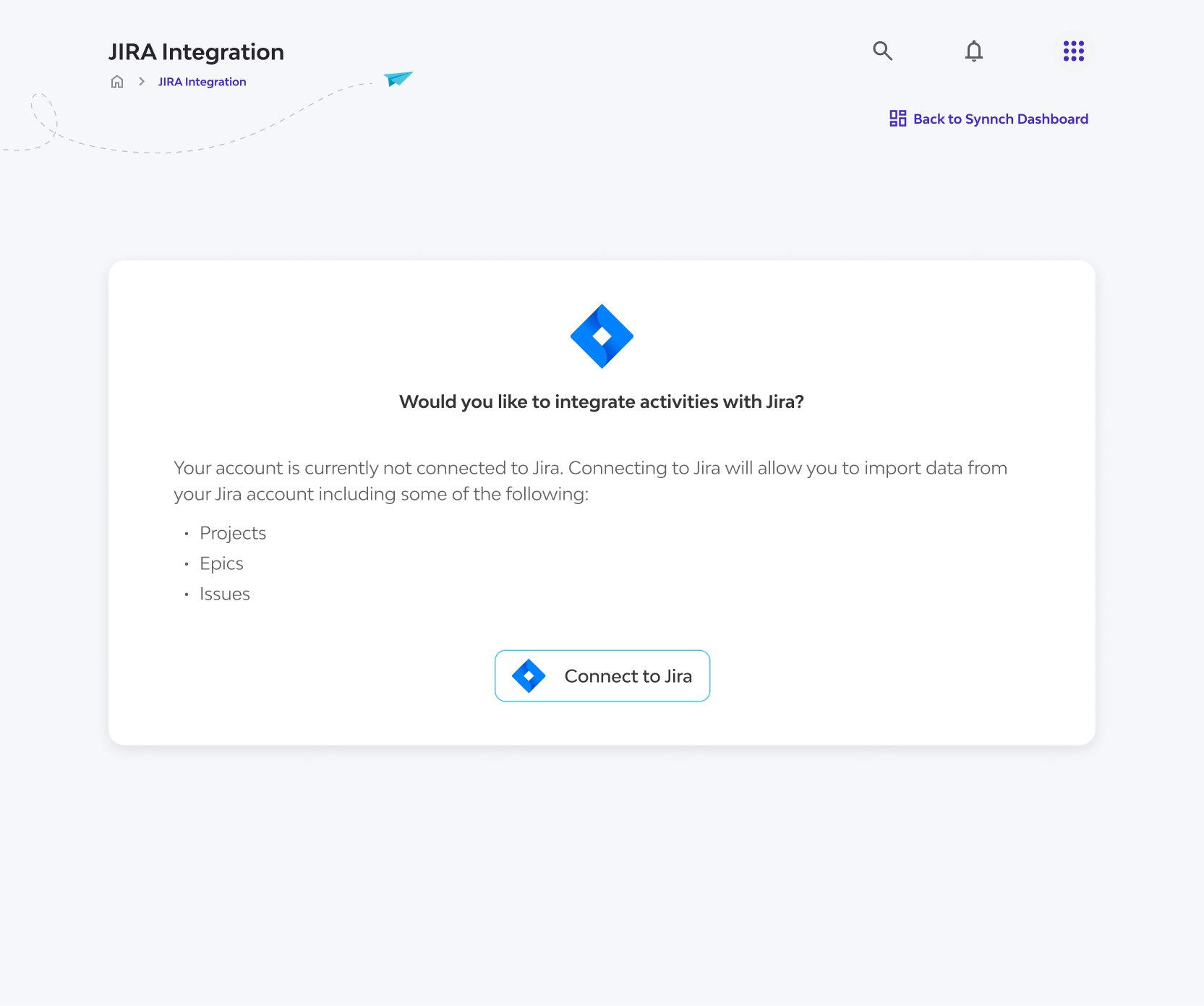
Authentication screen design

Jira Issues and Synnch Project selector page
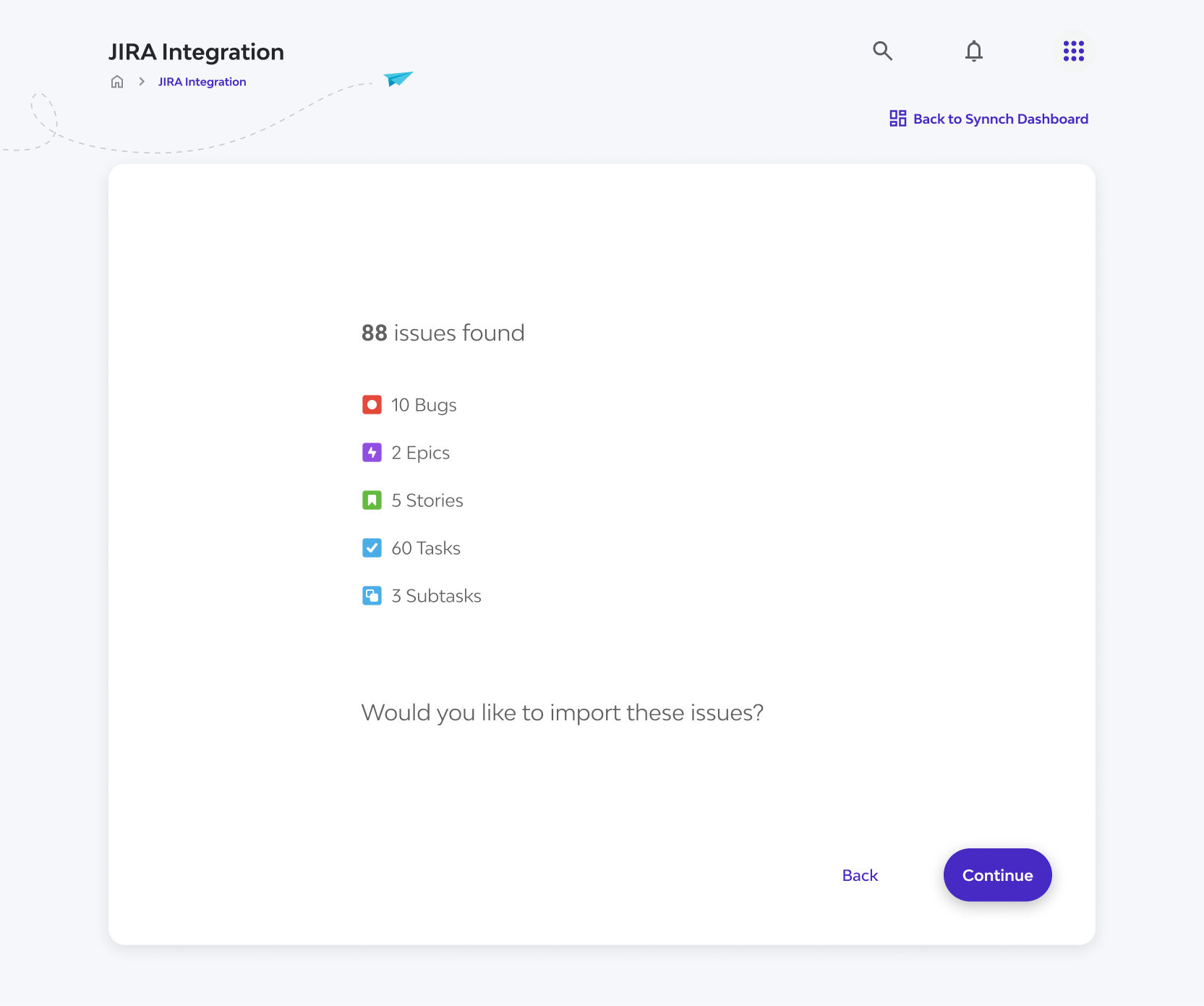
Count of Jira issues prior to matching



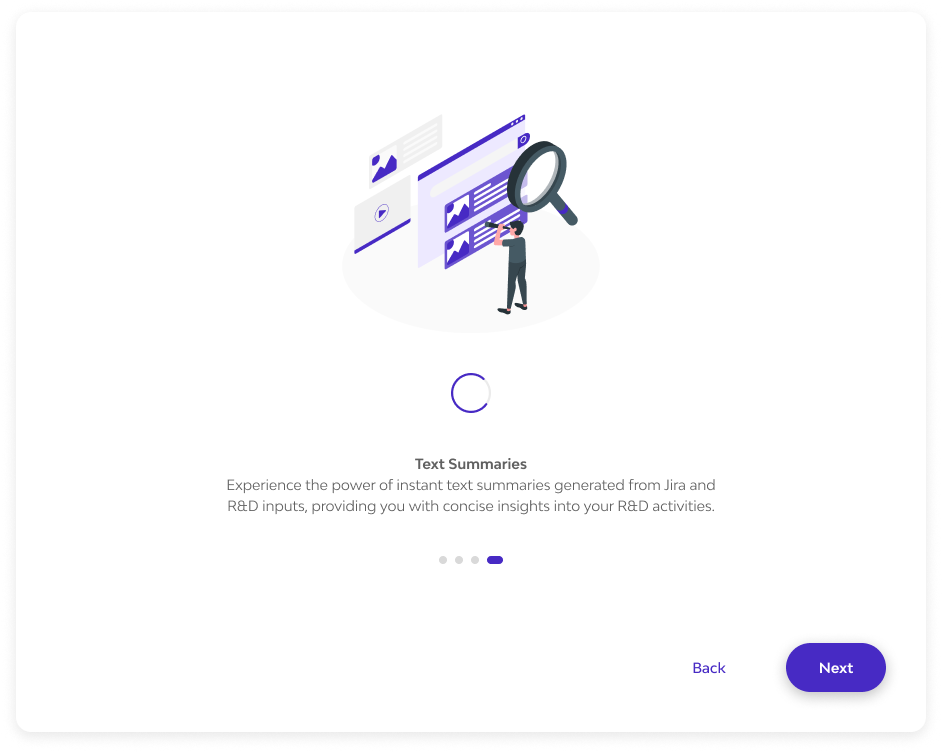
To manage user expectations during AI processing, visual sequences are displayed to commmunicate progress, and reduce perceived wait time.
Clear Evaluation & Processing UI
Implemented a clear 'Evaluate' call-to-action per Synnch activity. During AI processing, the UI provided feedback with loading indicators, helpful tips, real-time matching counts, and notifications for any skipped tickets, managing user expectation during wait times.

Designed a clear status progression for evaluating Jira issues against Synnch activities with interaction states tailored to each phase.

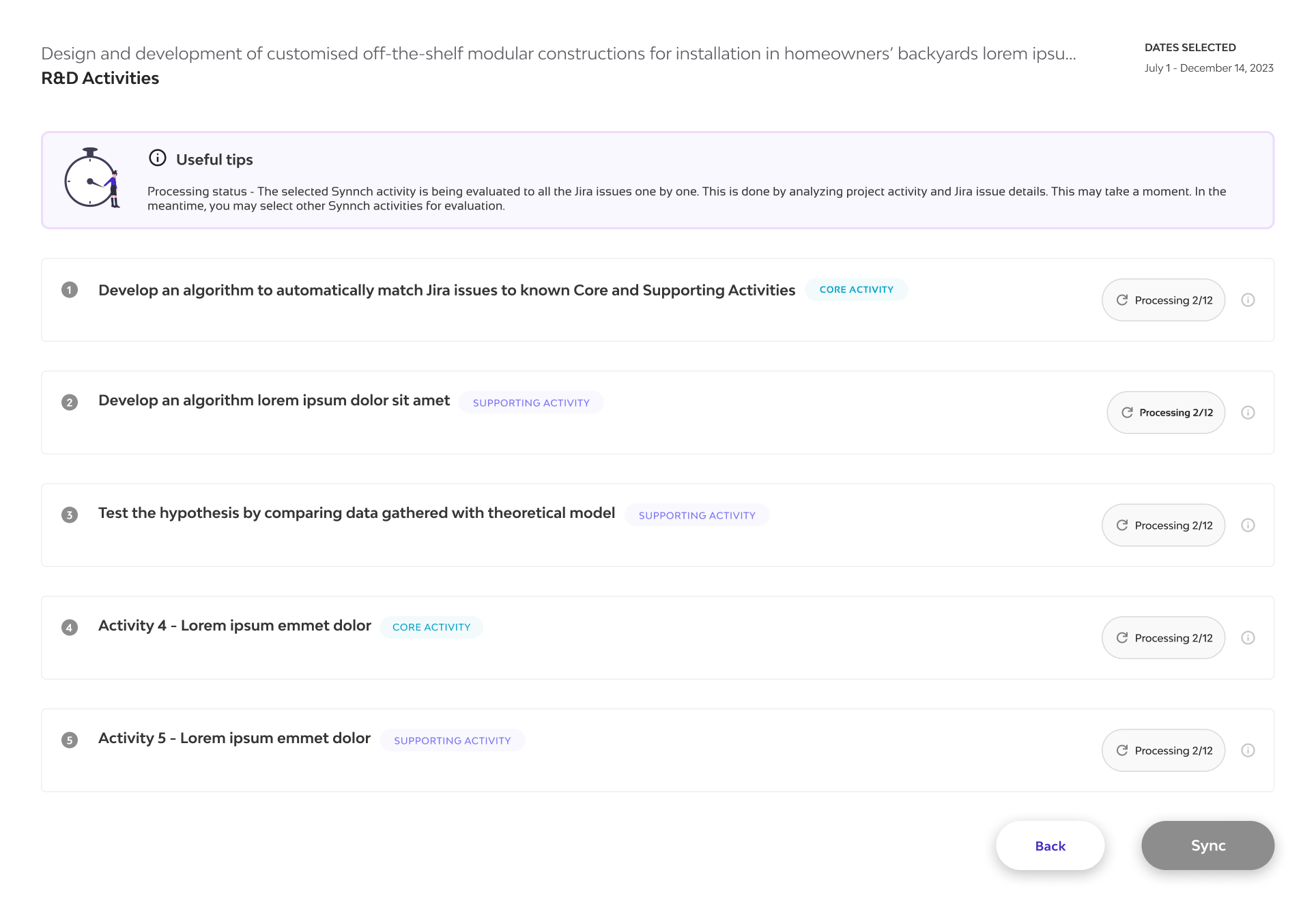

Design of the Synnch activity and Jira Issues evaluation page
Intuitive Matching Screen:
Designed the core matching interface for each Synnch activity, showing a summary of matched vs. unmatched Jira tickets. A detailed table lets users review each evaluated ticket, toggle its 'Match' status, and optionally add notes to explain their decision. Even with large volumes of data (e.g., 80+ tickets), the layout was optimized for clarity and ease of use.
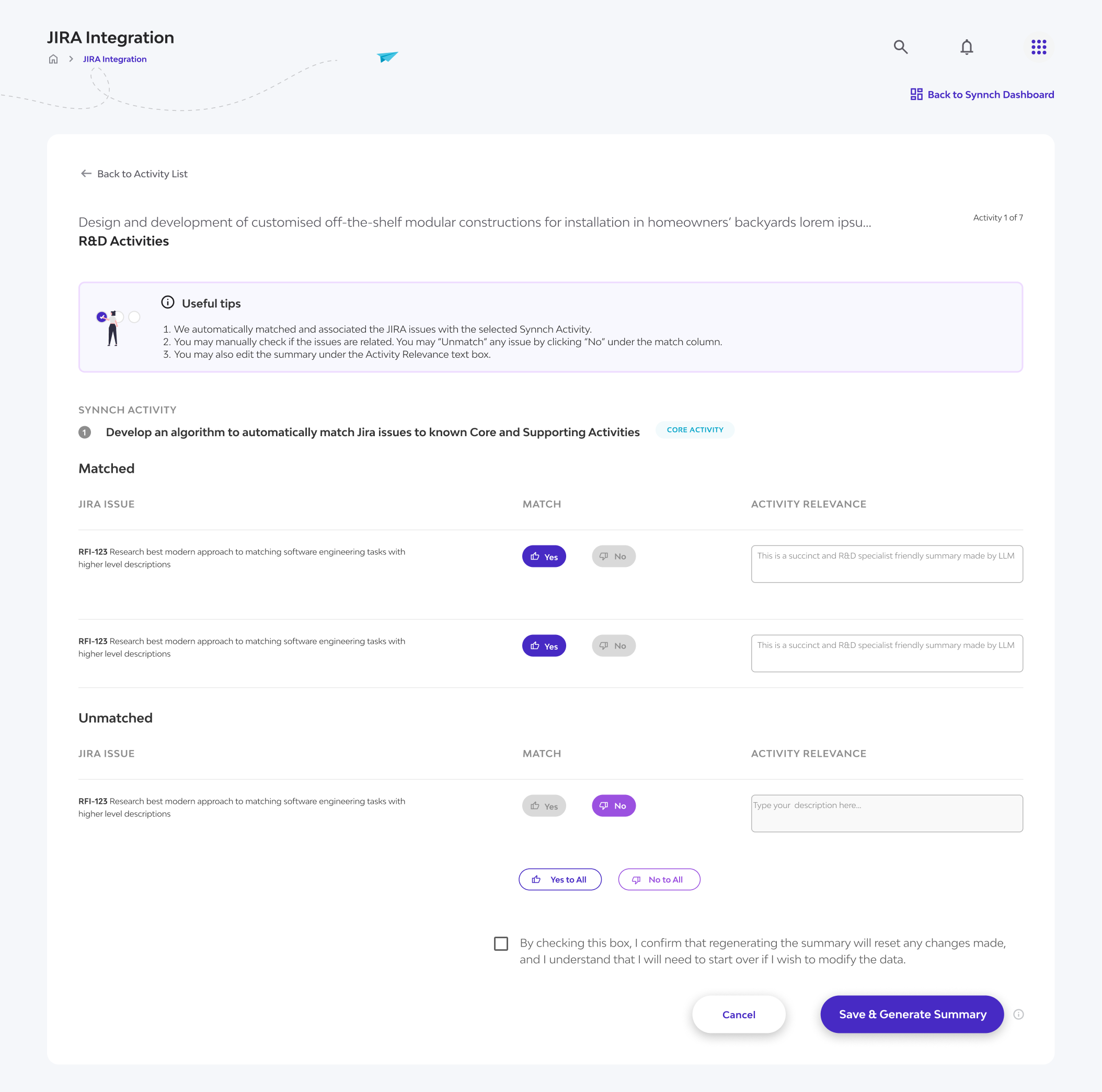
Once matching is complete, a table summary will be displayed showing which Jira tickets are matched. Users can edit this by matching, unmatching, or adding more insights for context as input to OpenAI.
Editable AI-Generated Summaries:
After review, users click 'Generate Activity Summary'. The resulting summary is clearly labelled as AI-generated and presented within the Synnch activity context, ready for review and linking to timesheets/evidence.
Final Sync to Synnch:
A distinct 'Sync' button becomes active once a summary is generated, allowing the user to confidently push the new R&D activity summary into the main Synnch Projects module.
Prototypes
Developed interactive prototypes covering the end-to-end flow, focusing particularly on the setup wizard, the data-heavy matching screen interactions, and the AI processing/waiting states.
Design System
Adhered strictly to the Synnch UI kit, reusing existing components (tables, buttons, modals, notifications) for consistency and development efficiency.
Rationale
The step-by-step wizard simplifies setup. The waiting time UI manages user perception. The matching screen, inspired by reconciliation patterns, balances data display with clear user actions (Match/Unmatch/Notes). Editable summaries provide necessary user control. The entire flow drastically reduces manual effort compared to disconnected systems.
V. Impact and Results
Outcome
Delivered a robust, guided Jira integration module for Synnch, transforming a previously manual and error-prone process into a streamlined, semi-automated workflow.
🎯 Intended Measurable Impact
- Aims to drastically reduce time spent on duplicating R&D documentation from Jira (potentially saving hours per claim).
- Improves consistency and accuracy by directly linking Jira work to R&D claims.
- Helps capture potentially missed R&D activities tracked only in Jira.
- Directly addresses and solves workflow inefficiencies
VI. Learning & Reflections
Key Takeaways
This project highlighted the value of breaking down highly complex workflows into digestible, guided steps for the user. Designing intuitive interfaces for data-matching tasks requires immense clarity and careful information architecture. I learned the importance of proactively managing user perception during inevitable system processing or waiting times.
Learn and Adapt
This project reinforced the importance of learning through doing. I wouldn’t have known how to iterate the design effectively without experiencing it in a live environment. Once the app was built, we uncovered real-world challenges — such as inconsistent AI results and user uncertainty during processing. In response, we introduced real-time Jira issue counts to reduce user anxiety and identified the waiting period as an opportunity to display helpful, reassuring content.
Future Considerations
Key areas for future improvement include addressing the current inability to edit past sync sessions (requiring users to redo matching) and mitigating potential user confusion from multiple summaries generated on resyncs. We also needed to ensure the stability of AI results for long-term success.